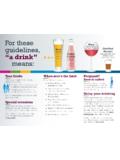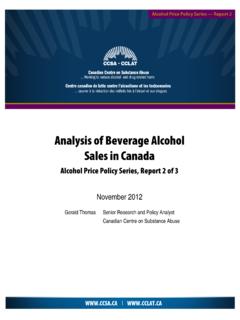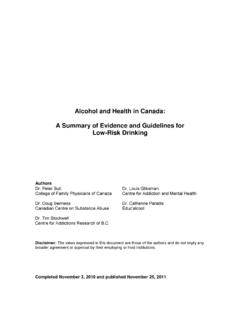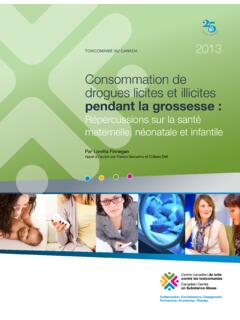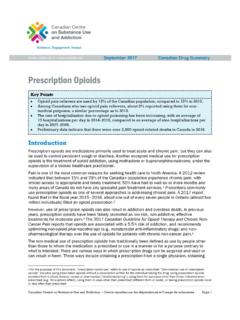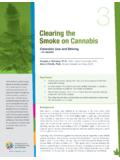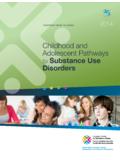Transcription of Reducing Alcohol-Related Harm
1 Toward a Culture of ModerationToward a Culture of ModerationReducing Alcohol-Related harm in Canada: Recommendations for aNational Alcohol StrategyApril 2007 Reducing Alcohol-Related harm in Canada:iiDear colleague,On behalf of the National Alcohol StrategyWorking Group, we are pleased to provide you with Reducing Alcohol-Related harm inCanada: Toward a Culture of Moderation Recommendations for a National Alcohol you know, alcohol is a legal commodity that has economic and social benefits, but italso has high potential for harm when usedinappropriately. The recent Cost of SubstanceAbuse in Canada Report estimated that, in2002, the economic impact of alcohol-relatedharm in Canada totalled $ , taking intoaccount the costs associated with lostproductivity, health care, and amount is slightly less than the estimatedcost of tobacco at $17B, but nearly double thecost attributed to illegal drugs at $ cross-country consultations onsubstance use and abuse held in 2005, the need to address alcohol misuse in Canada was repeatedly identified as an issue requiringnational attention.
2 As a result, Health Canada,the Canadian Centre on Substance Abuse, andthe Alberta Alcohol and Drug Abuse Com-mission jointly created an expert workinggroup to study the situation and developrecommendations for a National National Alcohol Strategy Working Groupwas composed of a wide range of stakeholdersand included representatives from federal, pro-vincial and territorial governments, addictionsagencies, academia, non-governmentalorganizations, and the alcohol beverage andhospitality industries. Following considerablework, the group reached general consensus on a comprehensive strategy that recognizes therespective roles of all players in addressingalcohol- related harm , and identifies a total of 41 recommendations in four broad areas foraction: Health promotion, prevention andeducation which aims to raise publicawareness about responsible alcohol use; Health impacts and treatment whichaims to reduce the negative health impactsof alcohol consumption and address itscontribution to injury and chronic disease.
3 availability of alcohol which aims toimplement and enforce effective measuresthat control alcohol availability ; and, Safer communities which aims to createsafer communities and minimize harmsrelated to notion of sensible alcohol use, ordeveloping a culture where moderation is the goal, underpins the recommendations for a National Alcohol Strategy. Similar to the cultural change that led to a decrease intobacco use or to acceptance of mandatory seat belt use, Reducing Alcohol-Related harm in Canada will require multi-faceted and long-term approaches which focus on social valuesand norms, along with a mix of socialmarketing, community information, regulation,and enforcement the strategy may not completely addressthe needs of First Nations, Inuit or Metis, theworking group supports additional work thatmore fully engages these communities andtheir leadership.
4 In addition, it is recognizedthat the issues around Fetal Alcohol SpectrumDisorder (FASD) are too complex to deal withcomprehensively in these recommendations. As such, the working group encourages allsectors to continue to make efforts to preventFASD and support those who live with it. Toward a Culture of ModerationiiiImplementing recommendations to reducealcohol- related harm will take time,commitment and collaboration amongst all key players. The Working Group hopes that you will find the recommendations in thisreport ,Co-Chairs of the National Alcohol StrategyWorking GroupReducing Alcohol-Related harm in Canada.
5 IvCanadian Centre on Substance AbuseSuite 30075 Albert StreetOttawa, OntarioK1P 5E7 Drug Strategy and ControlledSubstances ProgrammeHealth Canada123 Slater StreetOttawa, OntarioK1A 0K9 Alberta Alcohol and Drug AbuseCommission10909 Avenue JasperEdmonton, AlbertaT5J 3M9 Beth PietersonDirector GeneralMichel PerronChief Executive OfficerMurray FinnertyChief Executive OfficerToward a Culture of ModerationvTa b l e o f C o n t e n t s1. Executive Summary .. 12. Introduction .. 33. Strategic areas for action .. Health promotion, prevention and education .. Health impacts and treatment .. availability of alcohol.
6 Safer communities ..174. Conclusion.. 235. Bibliography .. 256. Recommendations .. 277. National Alcohol Strategy Working Group members .. 31 Note: This document reflects the generalconsensus of the National AlcoholStrategy Working Group onrecommendations for a NationalAlcohol Alcohol-Related harm in Canada:viToward a Culture of Moderation1 Alcohol is no ordinary commodity. It is a legal psychoactive drug that enjoys enormouspopularity and special social and culturalsignificance in Canada. Evidence also suggeststhat alcohol consumed at low to moderatelevels can benefit the health of someindividuals. Alcohol also plays an importantrole in the Canadian economy, generating jobs and tax revenue for , alcohol use is also a public healthissue as it can contribute to health and socialharms.
7 In 2002, the cost of alcohol-relatedharm totaled $ billion, or $463 for everyliving Canadian. This included $ billion for lost productivity due to illness andpremature death, $ billion in direct healthcare costs, and $ billion in direct lawenforcement costs. This National Alcohol Strategy is acomprehensive, collaborative strategy thatprovides direction and recommendations toreduce Alcohol-Related harm . It proposesrenewed efforts in health promotion,prevention, treatment, and enforcement. To implement the Strategy, a range ofapproaches is required, including those thatfocus on overall levels of alcohol consumption(population-level approaches) as well as thosethat target specific, high-risk drinking patternsand/or vulnerable populations (targetedinterventions).
8 The notion of sensible alcohol use, or develo-ping a culture where moderation is the goal,underpins the Strategy. Moving towards aculture of moderation signals a new way ofthinking about alcohol use that includes anunderstanding of when, when not, and howmuch to drink, appropriate motivations fordrinking and settings in which responsibledrinking should take place. It requires anunderstanding of the different risks involved in drinking both acute injuries and chronicdiseases and learning how to minimize these Strategy identifies four strategic areas foraction: health promotion, prevention andeducation; health impacts and treatment; availability of alcohol; and safer health promotion, prevention and educationarea aims to raise public awareness aboutresponsible alcohol use and enhance thecapacity and resilience of individuals andcommunities to participate in a culture ofmoderation.
9 Establishing a common under-standing of what constitutes sensible drinkingis critical to achieving a culture of moderationthat would encourage all Canadians to makehealthy and informed decisions about their use of alcohol. A key recommendation is thedevelopment of national alcohol drinkingguidelines, which would provide a benchmarkfor Canadians in evaluating their personaldrinking practices. The aim of the recommendations related tohealth impacts and treatmentis to reduce thenegative health impacts of alcohol consump-tion and address its contribution to injury andchronic disease. A key recommendation withinthis section is expansion of the use of varioushealth professionals to implement screening,brief interventions and referrals for those whomay be at risk of developing, or may alreadyhave developed, Alcohol-Related problems.
10 It is anticipated that such early interventionswould yield savings to both the health andsocial service and justice systems that wouldoffset the initial costs of of additional treatment optionsand specialist treatment services is Alcohol-Related harm in Canada: To w a r d a C u l t u r e o f M o d e r a t i o n1. Executive SummaryReducing Alcohol-Related harm in Canada:2 The availability of alcoholsection aims toimplement and enforce effective measures thatcontrol alcohol availability . It recommendsshoring up the social responsibility mandate ofgovernment liquor control boards, reinforcingliquor licensing and enforcement regulations,and harmonizing minimum purchase agesacross Canada.
